During a particularly intense and prolonged muscular exercise a negative nitrogen balance condition is established due to the use of amino acids for energy purposes

At the end of the physical exercise the phenomenon of proteolysis remains high for several hours and is partly compensated by a significant increase in muscle protein synthesis. The magnitude of these two phenomena is related to the intensity of the work performed, to the plasma availability of amino acids and to their transport speed within the muscle fiber.
Seen in this light, the intake of a supplement based on amino acids in the 24-48 hours following intense training sessions seems effective for muscle recovery and / or growth.
Amino acid supplementation induces a better response to the training stimulus even if performed before the physical exercise.
Amino acids or proteins? Advantages and disadvantages of amino acid supplements
The use of supplements based on branched amino acids makes it possible to contain the intake of proteins in the diet by providing amino acids that are more intensely consumed and necessary for a good metabolic balance.
Amino acids are small bricks that, when held together by the peptide bond, form proteins. Post-exercise protein supplementation increases gastric acid secretion of hydrochloric acid needed to break these bonds and release amino acids in free form. Furthermore, a massive protein supplement helps to further acidify the organism that has already accumulated a significant amount of fatigue toxins.
Therefore, after an INTENSE AND EXTENDED AEROBIC EXERCISE the integration of amino acids in free form is certainly more suitable than the traditional protein integration. In these cases, the diet will help the process of detoxification of the body that has suffered: loss of water, mineral salts, acid substances, depletion of carbohydrate reserves and muscle wear.
A similar state of acidosis can be controlled by taking alkaline drinks rich in mineral salts, branched amino acids and suitable foods (alkalizing foods in order of power: figs, dried apricots, spinach, dates, beets, carrots, celery, pineapple, tomatoes, cherries, bananas, oranges).
Before training, protein supplementation is not recommended as it would unnecessarily strain the digestive system by removing blood from the active muscles. The branched amino acid supplements can instead be taken with a certain tranquility since they do not overload the digestive tract too much and can preserve the muscular masses.
Proteins are preferable to single amino acids after strength or power training. In these cases the extent of muscle synthesis is linked in a dose dependent manner to the presence of all essential and non-essential amino acids. In any case there are also supplements on the market that contain all the amino acids that are important for protein synthesis in free form. These products do not require digestion and are readily absorbed and used by the body. However, their cost is significantly higher than traditional protein supplements.



